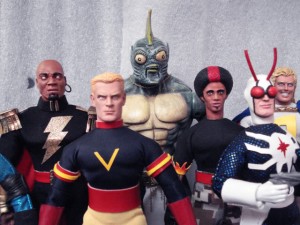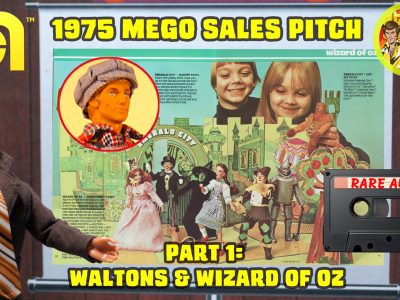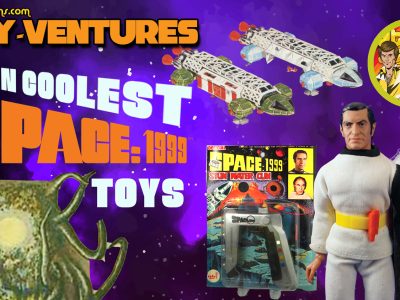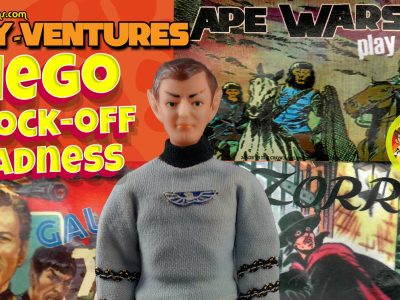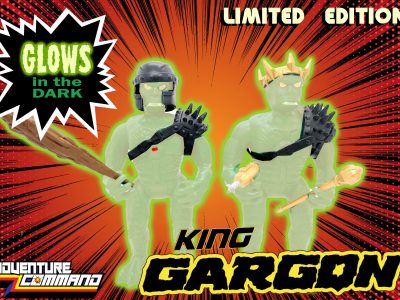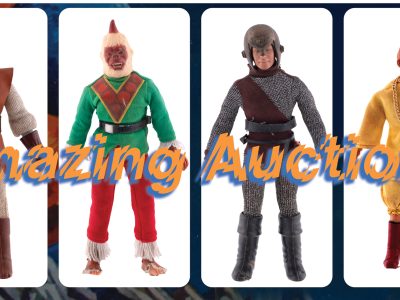For the month of August we’ll be highlighting the work of Scott Pierce, aka Random Axe. We originally interviewed Scott in 2008, and thought it would be interesting to catch back up with him.
Scott’s original interview can be found here:
https://www.megomuseum.com/custom/cotmscottpierce.shtml
The latest on Scott and his customs can be found in the following interview:
 EH: It’s been almost three years since we first interviewed you. Any changes on the personal front you’d like to report?
EH: It’s been almost three years since we first interviewed you. Any changes on the personal front you’d like to report?
Scott: I’m fatter yet wiser. I’m still married to Sandy, who has since become a member of the Museum. She has taken an interest in my hobby, which is much appreciated. I’m still a Shoe Carnival manager and have been for nearly ten years. Those hours don’t always provide me with the time I’d like to use for customizing, but I do pretty well. I’ve made a bunch of new friends here, some of which I know I’ll have for life. More than any rare Mego, that is the best acquisition I’ve made during my time on the Museum.
EH: You already had an impressive body of work. What has kept you going?
Scott: I’m always looking to improve and break boundaries that were previously an obstacle. I am constantly gathering ideas and inspiration from my fellow customizers and using those tools to create something new. Make no mistake, I could not do half of what I’ve accomplished without those before me like Jason, Derek, John, Anthony, Bob and Austin. They have helped shape my entire outlook and abilities in this hobby, and I’m sincerely grateful for their assistance and friendship.
I enjoy making customs of obscure characters that have never before been attempted. I’ve got a fairly large file of references for future projects of hardly known characters that would make outstanding figures. I’ve also gotten a huge thrill out of creating my own nonsense universe based on my book. I’ve been designing superheroes since I can remember, way back in Jr. high school, and many of those concepts made it into my current set of figures. My wife pushes me to keep at it and claims to enjoy watching me work. With that kind of support system, it’s pretty easy to continue my customizing journey.
EH: Your figures from three years ago are nothing to sneeze at by any means, but your style and abilities have evolved. Is it just due to time and repetition, or have you discovered some new tricks of the trade? You shared an interesting approach to sewing tricky fabric awhile back, can you expand on that?
Scott: Mostly, I’m way more patient. Before, I was trying to complete figures in a short window of time and not really putting in the hours it takes to be successful. I was rushing through the figure in front of me so I could hurry up and get to the next one. That led to several projects never meeting their potential, and in my mind, that’s failure. I now have every aspect of my current project planned out, mapped out and designed before needle meets thread. Not everything I plan works, but each failed attempt is a learning experience.
I’ve also learned to use new materials and fabrics and have done some machine sewing. My mother, who made me a 12” Captain America suit fifteen years ago, has been teaching me a lot about using needle and thread and about completing a figure, front and back. Together we developed a technique for sewing spandex, my fabric of choice. It’s slick, floppy and generally a pain to sew in such small scale. I use a basic suit pattern and several safety pins as I attach it to folded-over spandex. After making sure the pattern is in place and not moving, I just sew right onto the paper. This gives the spandex weight and makes it considerably more workable and substantial. Once you’ve gone over each stitch twice, peel away the paper and turn it. Using a blunt needle for spandex is best as sharp ones will catch and snap the thread.
EH: I’ve learned something already – I would never had thought the sharpness of a needle would make a difference. You also have a signature style when it comes to head paints. For those who missed you in action at Mego Meet, can you tell a little about your approach? Favorite paint, brushes….helpful hints?
Scott: I’ve got a background in color theory and paint, so I was happy those skills and lessons translated into Mego customizing. I am highly influenced by Frank Frazetta and Larry Elmore. I obviously do not have a classic style or even a Mego style, which both sets me apart and pigeonholes me. There are many collectors and customizing enthusiasts that only really care about figures that emulate vintage Megos. That’s cool, you like what you like. I decided early on that I was going to go the photorealistic route. For me, any figure in any scale from any designer or company begins and ends with the head. It’s the first thing you notice and is the last thing that makes an impression. My other skills are average to above average, so I thought maybe I’d counter that with the one thing I’m fairly good at.
My entire philosophy with paint is contrast. There is a fine line between dark and light. In nature there is nothing that is completely black or pure white. Mixing those into your paint colors to change shades rarely works out and ends up fading the original pigment. If you mix every color in your paint box you end up with …brown. Mixing crimson, Prussian blue and a deep forest green will give you a very, very dark color that’s almost black, but much more organic.
For flesh tones, I usually mix three different colors for the base and mix a few lighter shades for highlights. On any given head I paint there are usually five to seven layers of shades and color. You have to use the best brushes, period. Spend the extra money and get a nice sable set and thoroughly clean them when your session is over. Ninety percent of my paints come from Michael’s and Hobby Lobby. The most difficult paints to get right are red and yellow. Again, spend the extra money and get Games Workshop for those. You can sometimes just use one coat where you will be using four or more with the cheap stuff, and they will never look as bright or vivid.
EH: That explains why the heads on your figures have so much depth. A lot of your recent work has revolved around the comic universe you’ve been creating the past few years. How has working on your characters in both mediums helped the project overall? Can you give us a quick rundown on the roster as it stands right now, and share where the project is headed?
Scott: Oh yes, the great American novel. Initially, when I started Tales from Ultra City, I’d written quite a bit before I realized I was in waaaaaaay over my head. I was trying to blend in all of these characters into one, cohesive story. It never would have worked. Now, I’m breaking the book down into eight to ten individual stories each highlighting a different character or team. While building up the artistic juices for writing, I decided to make some figures representing my creations. This is actually how I came across Dr. Mego and the world of customs and eventually lead me to the Museum some four years ago.
All of my creations are pretty blatantly inspired by existing and historic comic characters, some subconsciously. An example would be Brohawk. He’s this insanely gifted fighter and tactician with indestructible hands who’s hung up on his feeling racially discriminated. It wasn’t till much later I realized I’d combined Power Man and Iron Fist into one character. If one were to delve into my creations, Captain Awesome, Major Power, Green Cougar and others are fairly transparent in their origins. The book is both a tribute to and a parody of the comics that shaped my childhood and still have a lasting impression on me.
EH: Aside from the Scott-verse, what customs do you see on your plate in the coming months?
Scott: I’m feeling really dialed-in after the Meet, really focused. It’s an amazing feeling to see that others actually like my work enough to write me or inquire about certain figures. I am unaccustomed to that kind of interaction, but it’s most welcomed. I’m literally shocked I’m the first re-interview here. So, back to the question, I’ve got some projects coming that will be, if I do them properly, some of my best work to date. I’m concentrating on making figures that are “finished”, that are professional. I’m doing my best to graduate from the amateurs to the pros.
I have four specific figures I’m making, some of them will be for next year’s Meet and some will be available once I finish them. I am making a new shiny Flash, a new version of Black Adam, a movie character and a re-Mego version of a long dead toy line, one I’ve never seen attempted before. I’ve got most of them completely mapped out and diagramed. Once I have all of the parts and materials, I’ll get to work. I am also gathering the parts for the auction winner from the Meet.
My ultimate goal, which will take some time, is to make the entire Squadron Supreme, the Mark Gruenwald version. That series seriously impacted me when I first read it. I’d like to do that story and Mark some justice.
EH: With a nod to the original CotM interview, what is your favorite re-mego figure or line? Has the resurgence in the 8” format affected your customizing habits?
I don’t want to come across as ungrateful or apathetic towards this resurgence, but the great majority of the licensed lines are just not for me. I should like them more, I know that. I think I’m way too picky. The DC retro action was an inspired toy line and I’m grateful for their existence and for the work put into them by our own Museum members. There were a few missteps along the way that are well documented, but they managed to make a few outstanding figures that I have in my small collection. Zica really set the bar high, and I don’t see any other manufacturer topping Buck Rogers. I’ll still get some BBP Ventures as I’ve recently discovered the cartoon.
From a customizer’s perspective, I end up spending my money on parts rather than re-Mego or vintage figures. My craft is currently more important than my collection. The new figures do not play any part in my customizing. I know many have used these for kitbashes and making their own versions, and that’s great. Anything that stokes the fires of imagination is terrific thing. Personally, though, this modern Mego revolution has not affected my customs.
EH: Thank you for being our guinea pig for the first ‘Then and Now’ feature Scott. Hopefully we can do this again in a few years. Any parting words?
Scott: Hey, I’m up for anything like this. I’m a social chameleon, so I’m always up for more interaction with my fellow board members. Hopefully this wasn’t the most boring thing they’ve read this year. I’m 42 years old and I play with dolls. Not exactly biopic material. I have no ego to stroke and no heart to break. I just do what I do and maybe a couple of people will like it.
Three years? I’ll still be around and maybe I’ll finally have completed the book. My sincere thanks go out to all of you I’ve met in person and those with whom I correspond. As someone who is good with words, I don’t have any adequate enough to express my gratitude for this board and its members. Just know I have much love for you, the hobby and the Museum.
EH: Thanks again Scott! See examples of Scott’s recent work in the gallery below.
[nggallery id=9]

